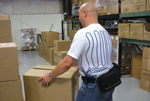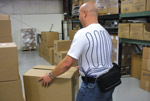
How Heat Stress Affects Performance
When the ambient temperature of the surrounding air is 95 degrees F or higher, radiation, convection, and conduction stop working. Evaporation is all that is left to cool the body.
- By Bruce Baker, John LaDue
- May 01, 2010

Education of employees is the most critical element in reducing heat stress-related accidents in the workplace.
NIOSH notes in its publication "Occupational Exposure to Hot Environments," (1986) that although workers can acclimatize themselves to different levels of heat, each worker has an upper limit for heat stress beyond which that worker can become a heat casualty. Further, it has been shown that a worker's ability to focus attention and the worker's reaction times can be dramatically reduced by even a 2 percent dehydration level due to heat stress.
It's accepted that businesses such as foundries, heavy machine manufacturing, shipbuilding, and a variety of others have areas that subject employees to heat stress. In temperatures as low as 80 degrees Fahrenheit, the human body compensates for heat levels in the inner core by pumping blood to the skin for cooling. When combined with the fact that most people (an estimated 80 percent of the U.S. population) start the day in a dehydrated state, heat stress is a major contributing factor in preventable accidents and work-related injury.
Many types of businesses encounter daily activity that can cause heat stress in the people who work for them and do not even know it! "We have always done things this way" is a quote that is all too familiar when asked why preventive measures were not taken to prevent heat stress in the workplace.
This is how the body releases heat under normal circumstances:
1. Sixty-five percent of the body's heat is released through radiation. This occurs when the ambient air temperature is lower than the body's skin temperature. Radiation is the movement of heat energy from a warmer object to a cooler object.
2. Convection accounts for approximately 10 percent of heat loss. Convection is the transfer of heat energy from a warmer object or space to a cooler object or space through differences in density and the action of gravity.
3. Approximately 23 percent of heat loss is due to evaporation of perspiration from the skin. Evaporation is the cooling of a surface through the process of a liquid changing to a vapor and leaving that surface.
4. Conduction will add another 2 percent to the heat loss total. Conduction is the transfer of heat energy from a warmer object to a cooler object through direct contact.
When the ambient temperature of the surrounding air is 95 degrees F or higher, radiation, convection, and conduction stop working. Evaporation is all that is leftto cool the body. Protective clothing used by welders, firefighters, racers, and hazmat workers will make the heat situation even worse.
A performance study by NASA using telegraph key operators showed that in temperatures of 80 degrees F, the operator will make five errors an hour and 19 mistakes after three hours. At 90 degrees F, the operators made nine mistakes per hour -- 27 after three hours. At 95 degrees F, the mistakes went to 60 in one hour and 138 in three hours. Although errors made by telegraph key operators may not be critical, this same hot environment will produce a proportional amount of errors, regardless of the task.
When a person is in a hot environment, up to 48 percent of his blood is pumped by the heart to the skin for cooling. The first effect is to release heat, but water is also released through perspiration. If an individual loses 2 percent of body weight due to perspiring, that person is considered to be in a heat exhausted state. A study by Wasterlund and Chaseling1 placed forest workers in a controlled environment where one group was properly hydrated and the other dehydrated to an extent of 1 percent of body weight loss. The test included the time taken to debark and stack 2.4 cubic meters of plywood. They found a 12 percent decrease in productivity from the dehydrated group.
Another study by Gopinthan et al.2 focused on mental performance and the effects of dehydration on the decision-making process and its connection to an increase in work-related accidents. The study concluded that with 2 percent of body weight loss, visual motor tracking, short-term memory, attention, and arithmetic efficiency were all impaired. In the extreme, the study notes that a 23 percent reduction in reaction time occurred with a 4 percent body fluid loss.
Warning Signs
At the ambient temperature of 95 degrees F, the body can no longer keep up with its internal heat generation levels, and inner core temperature begins to rise. The only mechanism to release body heat from the inner core is for up to 48 percent of the body's blood to be pumped to the skin to create perspiration. This creates two problems: blood loss to the organs, muscles, and brain; and dehydration.
When the brain, muscles, and major organs are receiving half of the blood they normally receive, the heart must work much harder to try to deliver the same volume of blood to those organs to keep them nourished by beating up to 150 times a minute. Then also factor in a thickening of the blood due to fluid loss (dehydration), and you begin to understand why heart attacks are a major byproduct of heat stress.
When an employee performs heavy, physical work, fluid intake may not overcome the effects of sweat output. Employees who perform duties in fully encapsulated protective clothing may have increased sweat rates of 2.25 liters per hour. Other studies link job-related accidents to "orthostatic intolerance." Carter et al.3 established that with a 3 percent dehydration state caused by heat exposure, subjects experienced a significant reduction in cerebral blood flow velocity when changing from a seated to standing position, and this can cause workers to lose consciousness. This may lead one to believe that taking fluids to hydrate the body is enough to prevent heat stress; however, it can take as much as 24 hours for the body to absorb enough fluid to fully rehydrate.
Work may need to be curtailed while fluid is replaced, or the dehydration rate must be slowed by using personal cooling methods, such as misting fans, ice vests, or active cooling products that pump cooled fluid through tubing or a bladder sewn to a garment the employee wears under the protective clothing.
Warning signs of heat exhaustion are heavy perspiration, fatigue and weakness, muscle and body ache, headache, nausea, rapid heartbeat, confusion, loss of consciousness, and vomiting, with or without loss of consciousness.
Godek, Bartolozzi, et al.4 have shown that fluid intake alone does not reduce core body temperature. Action must be taken to allow the worker to cool in addition to taking fluid. The inner core temperature will continue to rise for up to 30 minutes after work is stopped unless other means are used to cool the blood that has been pumped to the skin for cooling.
While conduction accounts for only 2 percent of heat loss under normal circumstances, the "OSHA Technical Manual" (Section III: Chapter 4) talks about how active cooling products using water are useful in preventing heat stress by using conduction to enhance the body's capacity to cool. In fact, it has been demonstrated that water is 28 times faster in cooling a subject than cooled air. These products slow the rate at which the core body temperature rises by using conduction to greatly increase the body's capacity to cool the blood that is pumped to the skin during times of elevated core temperatures. In turn, this slows the fluid loss caused by sweating. By using shirts and vests that incorporate active cooling on about 40 percent of the body surface, the danger of heat stress can be greatly reduced.
The Importance of Heat Stress Training
Education of employees is the most critical element in reducing heat stress-related accidents in the workplace. Many workers and supervisors feel the need to "get the job done" in the toughest situations. When they do not take into account the effects that heat stress can have on the body, dangerous events can take place.
Reduction in cognitive function, attention span, and visual motor tracking can lead to mistakes that could have tragic consequences. Policies that allow workers to use products that help to prevent heat stress in the workplace will greatly reduce heat stress related-illness and injury.
Employee training and company policies must help the employees decide they can protect themselves from heat stress. And reducing heat stress will improve productivity and reduce accidents at the workplace.
References:
1. Wasterlund DS, Chaseling J, Burstrom L: The effect of fluid consumption on the forest workers’ performance strategy. Appl Ergon 35:29-36, 2004.
2. Gopinathan PM, Pichan G, Sharma VM: Role of dehydration in heat stress-induced variations in mental performance. Arch Environ Health 43:15-17, 1988.
3. Carter R 3rd, Cheuvront SN, Vernieuw CR, Sawka MN: Hypohydration and prior heat stress exacerbates decreases in cerebral blood flow velocity during standing. J Appl Physiol 101:1744-1750, 2006.
4. Godek S, Bartolozzi A, Burkholder R, Sugarman E, Dorshimer G: Core temperature and percentage of dehydration in professional football linemen and backs during preseason practice. J Athl Train 41(1):8-17, 2006.
This article originally appeared in the May 2010 issue of Occupational Health & Safety.
About the Authors
Bruce Baker, M.S., is Director of Research
and Development of Hospital Services
Division at Shafer Enterprises, LLC/Cool
Shirt.net.
John LaDue is Division
Sales Director for the Hospital Services
Division at Shafer Enterprises, LLC/Cool
Shirt.net.